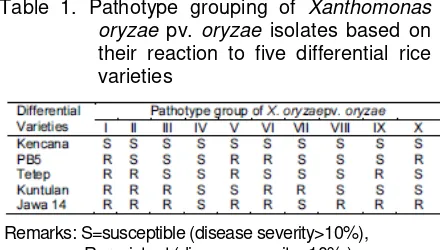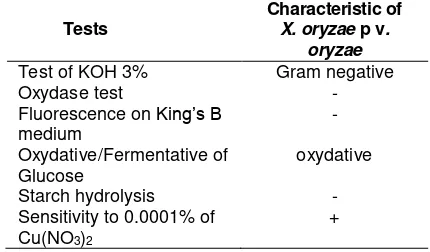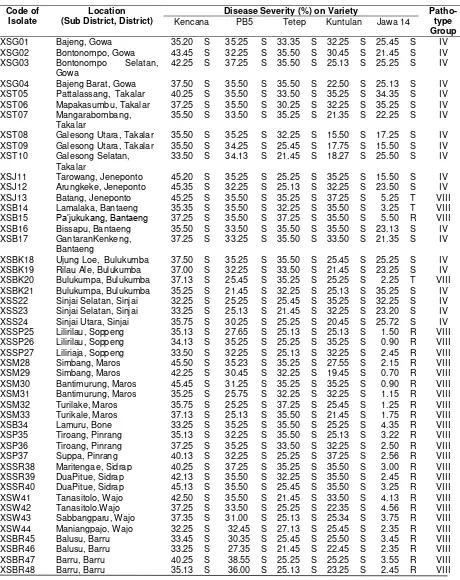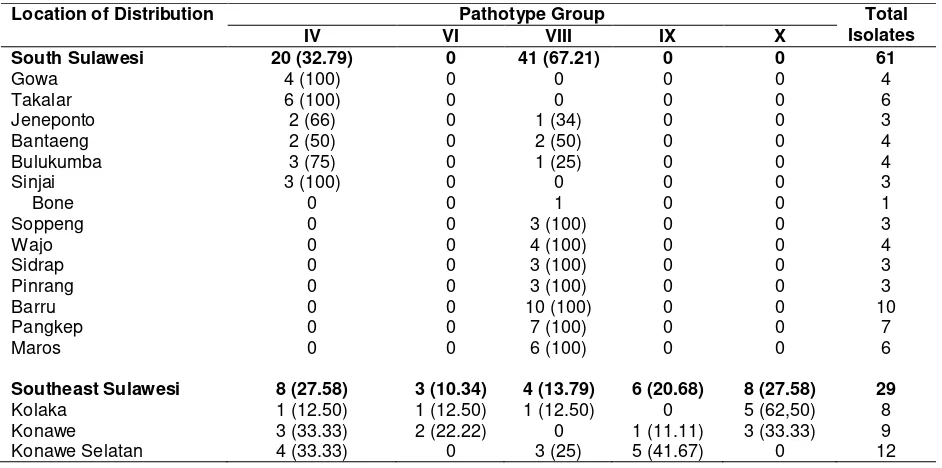PATHOTYPE GROUPING OF
Xanthomonas oryzae
pv.
oryzae
ISOLATES FROM SOUTH SULAWESI AND SOUTHEAST SULAWESI
Andi Khaeruni*) and Teguh Wijayanto
Department of Agrotechnology Faculty of Agiculture University of Haluoleo
Campus Bumi Tridharma, Jl. HEA. Mokodompit Andounohu Kendari Southeast Sulawesi Indonesia *) Coressponding author Phone : +62-401-3193596 E-mail: [email protected]
Received: January 12, 2013/ Accepted: May 29, 2013
ABSTRACT
Bacterial leaf blight caused by Xanthomonas oryzae pv. oryzae (Xoo) is an important rice disease, and has caused significant economic losses. This research aimed to determine the pathotype grouping and the distribution of Xoo isolates of South and Southeast Sulawesi. In order to obtain the information, 61 Xoo isolates of South Sulawesi and 29 isolates of Southeast Sulawesi were evaluated for their pathotype grouping against 5 diffential varieties. Research results showed that in South Sulawesi there were 2 pathotype groups, namely pathotype IV (32.79%) and pathotype VIII (67.21%). Pathotype VIII was widely distributed over the Western and Central areas of South Sulawesi, whereas pathotype IV was widely distributed over the Southern area. In Southeast Sulawesi, it was found 5 pathotypes, namely pathotypes IV (27.58%), VI (10.34%), VIII (13.79%), IX (20.68%), and X (27.58%), with a limited and scattered distribution pattern on several areas. These results indicate that Xoo pathotype groups in South Sulawesi and Southeast Sulawesi are varied and tend to sift to more virulent pathotypes.
Keywords: bacterial leaf blight, pathotype group, Xanthomonas oryzae pv. oryzae
INTRODUCTION
Bacterial leaf blight disease caused by Xanthomonas oryzae pv. oryzae (Xoo) is one of the main diseases of rice in Indonesia (Hifni and Kardin, 1998, Semangun, 2004),and in other rice-producing countries such as Japan, India and Philiphine (OEPP/EPPO, 2007). In Indonesia, the disease could cause yield loss around 20-30% (Kadir et al., 2007), or even 70-80% on susceptible varieties during rainy season (Kadir, 1999).
Several studies have shown the variability of Xoo pathotypes or strains in rice-producing countries (Suparyono et. al., 2004; Muneer et. al., 2007; Keshavarz et al., 2011). The shifting of Xoo pathotypes in Indonesia constantly occures. Yamamoto et al. (1977 in Kadir,1999), reported that the dominant Xoo pathotypes found in rice fields in Indonesia were pathotypes III, IV and V. Research conducted in 1980s found that pathotypes III, VI, and VIII were the dominant pathotypes (Suparyono, 1984), and during rainy season in the years 1999/2000, pathotypes III, IV and VIII in West Java, Central Java, and Jogyakarta were found (Suparyono et al., 2004). Based on Kozaka system, there have currently been 12 Xoo pathotype groups with different levels of virulence found in Indonesia. In line with the overtime shifting of Xoo pathotypes in the fields, the efficiency of using resistant varieties is only temporary and limited to certain areas because the initially non-outstanding pathotypes can become outstanding pathotypes when the suitable host is available.
The spread of bacterial leaf blight disease in a few areas in Indonesia in recent years is believed to be due to the shift of Xoo pathotypes that become more virulent, the availability of susceptible hosts, and the suitability of climate conditions in the fields. Therefore, information on the distribution of Xoo pathotypes on certain areas is very important in designing the disease control strategy and developing rice varieties resistant to the bacterial leaf blight disease.This research aimed to determine the Xoo pathotype groups and their distribution over several rice planting areas in South Sulawesi and Southeast Sulawesi.
Accredited SK No.: 81/DIKTI/Kep/2011
MATERIALS AND METHODS
Sample Collection of Rice Leaves Showing the Symptom of Bacterial Leaf Blight
Samples were taken from several rice planting locations of South and Southeast Sulawesi, during rainy season in 2011. In South Sulawesi, the samples were collected from 15 districts: Gowa, Takalar, Bantaeng, Jenneponto, Bantaeng, Bulukumba, Sinjai, Bone, Soppeng, Wajo, Sidrap, Pinrang, Barru, Pangkep, and Maros. In South East Sulawesi, the samples were taken from Kolaka, Konawe and South Konawe district. Samples were randomly collected over rice planting areas by taking several leaf samples showing bacterial leaf blight symptoms. The leaf samples were put in plastic bags labeled with sampling date, location, and plant growth stage. Samples were transported to the laboratory for further examination.
Isolation of Xanthomonas oryzae pv.oryzae Isolation of Xoo from leaf tissues was performed by slicing the infected rice leaves by 0.5 cm x 0.5 cm over leaf area located between infected tissue and healthy tissue. The leaf pieces were sterilized in 70% ethanol for 5 minutes, and then rinsed twice with sterile aquadest. The leaf pieces were then chopped with sterile blade, added with 2 drops of sterile aquadest, and incubated for 5 minutes. The supernant containing bacterial cells from chopped leaves was streaked over Wakimoto medium, and incubated in room temperature for 2-4 days.
Grown bacterial colonies and showing Xoo characteristics (round colonies, mucoid and yellowish) were purified using a quadrant streak method on PSA medium (Potato 30 g, Sucrosa 20 g and Agar 20 g per liter), and incubated for 3-4 days. Purified isolates were kept in PSA medium in eppendorf containing 15% sterile glycerol, stored at – 20°C further tests.
Biochemical and Physiological Tests
Biochemical and physiological tests were conducted to make sure that the isolates were Xoo isolates. The tests performed were a gram test with KOH 3%, oxydative-fermentative test, starch hydrolysis test (Kerr, 1980 in Rasminah et al., 2010), and sensitivity test to Cu(NO3)2 (Djatmiko and Prakoso, 2010).
Inoculation of Xanthomonas oryzae pv. oryzae
on Differential Varieties
Xoo pathotypes was determined based on Kozaka system developed in Indonesia. The test was conducted in a glass house using 5 differential varieties: Kencana, PB5, Tetep, Kuntulan and Jawa 14 (Yamamoto et al., 1977 in Kadir, 1999). Tested isolates were isolates that were positive for Xoo based on biochemical and physiological tests. Seeds of the 5 differential rice varieties were germinated in plastic boxes containing media mixture of topsoil, rice hull, and organic matter (animal feces) (2:2:1). After 21 days, rice seedlings were moved to 35-cm polybags, one seedling per polybag, and then maintained in a screen house.
Xoo inoculation in tested plants was conducted using a “scissoring method”. A sterile scissor was dipped in inoculums suspension (concentration108 - 109 per ml) and used to cut leaf samples (5 upper fully-opened leaves), about 3 cm from leaf tip. Each Xoo isolate was tested on 2 rice clusters per variety. Observation of disease severity was based on the development of bacterial leaf blight symptoms on inoculated leaves, 14 to 21 days after inoculation.
Observation of Disease Severity and Determination of Pathotype
Disease severity was scored by measuring the ratio between the length of leaves with symptom and the length of overall leaves, stated in percentage (%). Reaction of individual plant to each isolate tested was categorized resistant if disease severity <10%, and susceptible if disease severity >10%. Determination of pathotype was based on a reciprocal relationship between differential varieties and isolates tested (Table 1).
Table 1. Pathotype grouping of Xanthomonas oryzae pv. oryzae isolates based on their reaction to five differential rice varieties
RESULTS AND DISCUSSION
Xanthomonas oryzae pv. oryzae Isolates from South Sulawesi and Southeast Sulawesi
Isolation of rice leaves having bacterial leaf blight symptoms resulted in 124 isolates (70 isolates from South Sulawesi and 54 isolates from Southeast Sulawesi) with Xanthomonas characteristics on Wakimoto medium, such as small rounded colonies, mucoid, and yellow in color. Results of biochemical and physiological tests on the 124 isolates indicated that 90 isolates (61 from South Sulawesi and 29 isolates from Southeast Sulawesi) were positive for Xoo, because they had physiological characteristics as shown in Table 2.
Remarks: + = positive (gowth), - = negative
Results of biochemical and physiological tests showed that not all isolates were Xoo eventhough they grew on Wakimoto medium and yellow in color. Out of 70 isolates from South Sulawesi, only 61 isolates (87.14%) had Xoo criteria, while only 55.56% out of 54 isolates from Southeast Sulawesi that were positive for Xoo. The low percentage of Xoo positive isolates from Southeast Sulawesi was partly due to the less development of the leaf blight symptoms, causing the difficulty in pathogen isolation. In South Sulawesi, however, the disease severity was high and the symptoms were obvious and specific, therefore the pathogen isolation was less difficult.
Xoo isolates were selected if they met the Xoo criteria, including gram negative reaction, oxidative, unfluorescence on King’s B medium, unable to hydrolyze starch, but can grow on PSA
medium containing 0.001% Cu(NO3)2. Liu et al. (2006) mentioned that one difference between Xoo causing bacterial leaf blight and X. oryzae pv. oryzacola causing bacterial leaf streak was its resistance to 0.001% Cu(NO3)2.. Xoo isolates, that grew on PSA medium containing 0.001% Cu(NO3)2, showed good growth and had yellow colonies. The 90 Xoo isolates were collected, and their geographic origins were shown in Table 3
Pathotype Grouping of Xanthomonas oryzae
pv.oryzae
Pathotype grouping of 90 isolates positive for Xoo was shown in Table 3. Out of 61 Xoo positive isolates from South Sulawesi, they were grouped into 2 pathotypes: patotype IV (32.79%) and pathotype VIII (67.21%). Xoo positive isolates from Southeast Sulawesi were grouped into 5 different pathotypes: pathotype IV (31.03%), pathotype VI (10.34%), pathotype VIII (10.34%), pathotype IX (20.70%), and pathotype X (27.59%).
The results of pathotype grouping indicated that the dominant pathotypes in South Sulawesi were pathotypes IV and VIII, while in Southeast Sulawesi were pathotypes IV and X. The dominance of pathotypes IV and VIII in South Sulawesi was similar to the report by Suparyono (2004), where it was stated that the same 2 dominant pathotypes in West Java, Central Java, and Jogjakarta were found. Hifni (1986) previously mentioned that the dominant Xoo pathotype in Indonesia was pathotype III, while Suryadi and Machmud (1987) reported that the dominant Xoo pathotype in Kerawang and Bekasi district was pathotype VI. With the current dominance of pathotypes IV and VIII, this indicates that there has been a shift in Xoo pathotypes towards more virulent pathotypes in several areas in Indonesia.
Table 3. Pathotype groups of X. oryzae pv. oryzae isolates from South Sulawesi and Southeast Sulawesi Code of
Isolate
Location (Sub District, District)
Disease Severity (%) on Variety Patho-type Group Kencana PB5 Tetep Kuntulan Jawa 14
XSG01 Bajeng, Gowa 35.20 S 35.25 S 33.35 S 32.25 S 25.45 S IV XSG02 Bontonompo, Gowa 43.45 S 32.25 S 35.50 S 30.45 S 21.45 S IV XSG03 Bontonompo Selatan,
Gowa
42.25 S 37.25 S 35.50 S 25.13 S 25.25 S IV
XSG04 Bajeng Barat, Gowa 37.50 S 35.50 S 35.50 S 22.50 S 25.13 S IV XST05 Pattalassang, Takalar 40.25 S 35.50 S 33.50 S 35.25 S 34.35 S IV XST06 Mapakasumbu, Takalar 37.25 S 35.50 S 30.25 S 32.25 S 35.25 S IV XST07 Mangarabombang,
Takalar
35.50 S 33.50 S 35.25 S 21.35 S 22.25 S IV
XST08 Galesong Utara, Takalar 35.50 S 35.25 S 32.25 S 15.50 S 17.25 S IV XST09 Galesong Utara, Takalar 35.50 S 34.25 S 25.45 S 17.75 S 15.50 S IV XST10 Galesong Selatan,
Takalar
33.50 S 34.13 S 21.45 S 18.27 S 25.50 S IV
XSJ11 Tarowang, Jeneponto 45.20 S 35.25 S 25.25 S 35.25 S 15.50 S IV XSJ12 Arungkeke, Jeneponto 45.35 S 32.25 S 25.13 S 32.25 S 23.50 S IV XSJ13 Batang, Jeneponto 45.25 S 35.50 S 35.25 S 37.25 S 5.25 T VIII XSB14 Lamalaka, Bantaeng 35.35 S 35.50 S 32.25 S 35.50 S 3.25 T VIII XSB15 Pa’jukukang, Bantaeng 37.25 S 35.50 S 37.25 S 35.50 S 5.50 R VIII XSB16 Bissapu, Bantaeng 35.50 S 33.50 S 35.50 S 35.50 S 23.13 S IV XSB17 GantaranKenkeng,
Bantaeng
37.25 S 33.25 S 35.50 S 33.50 S 21.35 S IV
XSPK58 Bungoro, Pangkep 42.13 S 27.25 S 21.35 S 21.35 S 2.50 R VIII XSPK59 Minasatene’, Pangkep 40.13 S 36.00 S 25.25 S 25.25 S 1.50 R VIII XSPK60 Ma’rang, Pangkep 45.25 S 35.35 S 23.25 S 23.13 S 2.50 R VIII XSPK61 Segeri, Pangkep 37.13 S 27.50 S 30.25 S 21.35 S 2.50 R VIII XTKL01 Samaturu, Kolaka 15.51 S 11.17 S 21.45 S 40.43 S 7.06 R VIII XTKL02 Samaturu,Kolaka 25.55 S 4.71 R 73.09 S 27.50 S 9.67 R X XTKL03 Samaturu, Kolaka 25.17 S 2.60 R 31.23 S 3.85 R 7.89 R VI XTKL04 Wolo, Kolaka 63.86 S 5.06 R 29.76 S 73.58 S 7.11 R X XTKL05 Wundulako, Kolaka 21.14 S 2.41 R 10.95 S 30.85 S 0.59 R X XTKL06 Wundulako, Kolaka 39.06 S 40.02 S 16.77 S 36.69 S 44.97 S IV XTKL07 Pomalaa, Kolaka 20.72 S 4.72 R 25.15 S 35.88 S 7.16 R X XTKL08 Ladongi, Kolaka 24,62 S 4.72 R 25.15 S 35.88 S 6.16 R X XTKW09 Wonggeduku, Konawe 24.72 S 4.78 R 25.15 S 35.88 S 7.79 R X XTKW10 Tongauna, Konawe 40.75 S 3.20 R 44.06 S 25.09 S 8.81 S X XTKW11 Tongauna, Konawe 31.33 S 41.74 S 43.09 S 59.72 S 48.71 S IV XTKW12 Tongauna, Konawe 31.68 S 41.74 S 43.62 S 56.42 S 46.81 S IV XTKW13 Tongauna, Konawe 22.70 S 9.79 R 14.53 S 2.97 R 3.87 R VI XTKW14 Uepai, Konawe 53.87 S 5.82 R 17.02 S 37.34 S 8.91 R X XTKW15 Wawotobi, Konawe 17.91 S 18.87 S 6.44 R 5.92 R 6.08 R IX XTKW16 Unaaha, Konawe 35.50 S 2.57 R 60.28 S 1.51 R 2.09 R IV XTKW17 Wonggedeku, Konawe 67.68 S 84.40 S 71.86 S 55.11 S 46.10 S IV XTKS18 Landono,Konawe Selatan 57.57 S 51.09 S 3.25 R 47.21 S 3.86 R IX XTKS19 Landono, Konawe
Selatan
64.86 S 89.99 S 97.60 S 94.33 S 6.21 R VIII
XTKS20 Landono, Konawe Selatan
28.37 S 37.30 S 58.09 S 41.53 S 16.98 S IV
XTKS21 Laea, Konawe Selatan 13.57 S 11.90 S 33.79 S 26.63 S 10.85 S IV XTKS22 Palangga, Konawe
Selatan
24.70 S 67.05 S 37.60 S 18.08 S 5.85 R VIII
XTKS23 Palangga, Konawe Selatan
19.76 S 10.10 S 60.41 S 52.46 S 22.82 S IV
XTKS24 Palangga, Konawe Selatan
83.21 S 31.93 S 63.41 S 44.52 S 34.44 S IV
XTKS25 Palangga, Konawe Selatan
37.84 S 42.96 S 77.57 S 42.06 S 3.07 R VIII
XTKS26 Lainea, Konawe Selatan 41.93 S 32.52 S 4.61 R 10.78 S 1.21 R IX XTKS27 Lainea, Konawe Selatan 19.19 S 14.84 S 5.58 R 16.77 S 6.14 R IX XTKS28 Laea, Konawe Selatan 15.06 S 10.33 S 7.51 R 50.21 S 2.11 R IX XTKS29 Laea, Konawe Selatan 17.07 S 11.53 S 7.61 R 50.01 S 2.81 R IX
Remarks: S: susceptible, R: resistant Table 3 (Continued)
Code of Isolate
Location (Sub District, District)
Disease Severity (%) on Variety Patho-type Group Kencana PB5 Tetep Kuntulan Jawa 14
Table 4. Geographic distributionof pathotype groups of X. oryzae pv. Oryzaein South Sulawesi and Southeast Sulawesi
Location of Distribution Pathotype Group Total
Isolates
IV VI VIII IX X
South Sulawesi 20 (32.79) 0 41 (67.21) 0 0 61
Gowa 4 (100) 0 0 0 0 4
Takalar 6 (100) 0 0 0 0 6
Jeneponto 2 (66) 0 1 (34) 0 0 3
Bantaeng 2 (50) 0 2 (50) 0 0 4
Bulukumba 3 (75) 0 1 (25) 0 0 4
Sinjai 3 (100) 0 0 0 0 3
Bone 0 0 1 0 0 1
Soppeng 0 0 3 (100) 0 0 3
Wajo 0 0 4 (100) 0 0 4
Sidrap 0 0 3 (100) 0 0 3
Pinrang 0 0 3 (100) 0 0 3
Barru 0 0 10 (100) 0 0 10
Pangkep 0 0 7 (100) 0 0 7
Maros 0 0 6 (100) 0 0 6
Southeast Sulawesi 8 (27.58) 3 (10.34) 4 (13.79) 6 (20.68) 8 (27.58) 29
Kolaka 1 (12.50) 1 (12.50) 1 (12.50) 0 5 (62,50) 8
Konawe 3 (33.33) 2 (22.22) 0 1 (11.11) 3 (33.33) 9
Konawe Selatan 4 (33.33) 0 3 (25) 5 (41.67) 0 12
Although the surveyed areas were still quite limited, the research results indicated that Xoo pathotypes distributed in South Sulawesi were not too diverse since there were only two pathotypes found. The pathotype distribution seemed to be in line with the geographic distribution, indicating that a wide area was dominated by a certain pathotype. The distribution pattern of Xoo pathotypes in Southeast Sulawesi was quite different from that of South Sulawesi. In Southeast Sulawesi, the pathotype distribution was concentrated in certain locations. However, sometimes between near locations there were different pathotype groups; therefore, within a single district two different pathotype groups were sometimes found. Xoo pathotype distribution in South and Southeast Sulawesi was shown in Table 4.
The difference in the distribution pattern of Xoo pathotype groups between the two provinces was probably caused by several factors. Firstly, the rice planting areas, in certain locations, in Southeast Sulawesi were generally much narrower that the planting areas in South Sulawesi. Secondly, irrigation system of rice planting areas in South Sulawesi was much better and more developed than that of Southeast Sulawesi. The irrigation system could be a good media for the spread of a certain pathotype group over wide areas. In Southeast Sulawesi, paddy rice planting areas are
in general scattered (separated by forest, villages, etc), which usually resulted in relatively limited pathotype distribution. Thirdly, rice varieties grown in wide areas in South Sulawesi were relatively uniform, while in Southeast Sulawesi the rice varieties grown were relatively more diverse. Suparyono et al. (2004), mentioned that one factor causing more variable Xoo pathotypes in certain locations was the diversity of varieties grown in those locations.
CONCLUSIONS
ACKNOWLEDGEMENTS
The Authors would like to thank Directorate General of Higher Education in accordance with the Letter of Ageement on Implementation of the Fundamental Research Grant, No.:0541/023-04.1.01/00/2011, which has funded this research. The authors also thank to Abdul Rahim and Mariana Anwar for technical work in the laboratory and in the field.
REFERENCES
Djatmiko, H.A. and B. Prakoso, 2010. Diversity of Xanthomonas oryzae pv. oryzae pathotypes on rice plants in three different altitudes based on RAPD pattern (in Indonesia). J. Agivita vol.32(2): 155-162. Hifni, H.R.1986. Grouping of Xanthomonas
campestris pv. oryzae bacteria based on their pathogenicity on rice varieties (in Indonesia). Agicultural Research. 6(2): 74-76.
Hifni, H.R. and M.K. Kardin. 1998. Grouping of Xanthomonas oryzae pv.oryzae isolates using IRRI isogenic lines (in Indonesia). Hayati 5: 66-72.
Kadir, T.S. 1999. Virulent variation of Xantho-monas oryzae pv. oryzae (in Indonesia). Proceedings of the 15th National Congess and Scientific Seminar of Indonesian Phytophatology Association. Purwokerto, 16-18 September.
Kadir, T.S., I. Hanarida and D.W. Utami. 2007. Influence of races III, IV and VIII of Xanthomonas oryzae pv. oryzae to production of double haploid population crosses IR64 and wilt species Oryza rufipogon. in Sumardiyono and Hartono (eds), The Role of Plant Pathology in Rapidly Globalizing Economies of Asia. Proceeding The Third Asian Coference on Plant Pathology. Yogyakarta, August 20-25. p.163-164.
Keshavars, K., K. Sijam, M.H.Z. Abidin, H. Habibudin and E. Nazerian. 2011. Rapid identification and differentiation of Xantho-monas oryzae pv. oryzae strain with primer 16S rDNA from rice fields in Peninsular Malaysia. Asian Journal of Plant Pathology 5(2): 93-99.
Liu, D.N., P.C. Ronald and A.J. Boddanova, 2006.Xanthomonas oryzae pathovars: model pathogens of a model crop. Molecular Plant Pathology 7: 57-59. Muneer, N., A. Rafi and M.A. Akhtar, 2007. Isolation
and characterization of Xanthomonas oryzae pv. oryzae isolates from North West Frontier Province Pakistan. Sarhad Journal Agiculture 23(3): 743-751
OEPP/EPPO, 2007. Xanthomonas oryzae. EPPO Bulletin 37: 543-553.
Rasminah, S.Ch.Sy, A.L. Abadi, N. Saleh and I. Royyana, 2010. Identification of causal bacteria for postharvest disease on sweetpotato (Ipomeabatatas) in Magetan and Mojokerto Districts. (in Indonesia) J. Agrivita 32(2): 137-145.
Semangun, H. 2004. Diseases of Important Food Crops in Indonesia (in Indonesia). Gadjah Mada University Press. Yogyakarta. Suparyono, 1984. Distribution of Xanthomonas
campetrispv. oryzae pathotypes, causal agent for bacterial leaf blight for rice in West Java (Tesis) (in Indonesia). Postgraduate Program. Gadjah Mada University. Yogyakarta. pp.37.
Suparyono, Sudir and Suprihanto, 2004. Patho-type profile of Xanthomonas oryzaepv. oryzae isolates from rice ecosystem in Java. Indonesia J. of Agriculture Science 5(2): 63-69.




